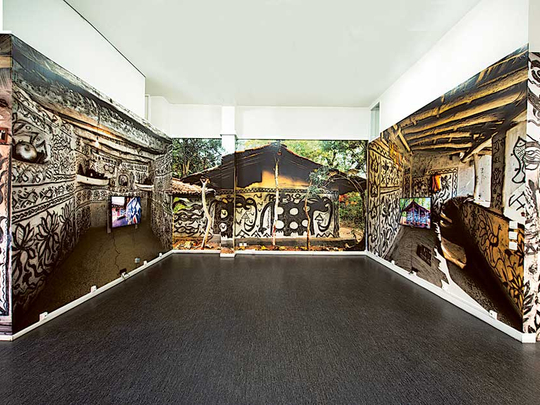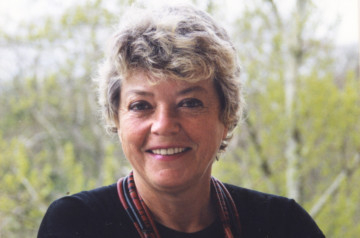
Tribal wall painting is an age-old tradition, passed down through the generations. Deep in the forests of Jharkhand in eastern India lie the tribal villages of Hazaribagh where mud homes are resplendent with bold, figurative murals. The designs are painted by women. Mothers pass on the painting skills to daughters.
The murals are known as “sohrai” (harvest festival art) and “khovar” (marriage murals). Sohrai comes from “soro”, meaning “to drive with a stick”. This autumn harvest painting is rendered with chewed twigs from sal trees, or with cloth swabs. Khovar is derived from “kho”, meaning cave, and “var”, meaning husband. The murals depict fertility and are made every year during the marriage season or spring. Women create the intricate art using fine combs of bamboo or with fingers.
Their art is now winning accolades at various exhibits around the world. It was showcased at Espace Callot art gallery in Paris at an exhibition that ran from October 6 to November 26.
The tribal wall paintings were captured by renowned architecture photographer and filmmaker Deidi von Schaewen and recreated as a 3D exhibition of photographs in real scale and size.
Von Schaewen says she has always been fascinated by painted walls. While travelling for her books “Interiors of India” and “Inside Africa” for the German publisher Taschen between 1995 and 2003, had accrued quite a big collection of photos of traditional houses with painted walls, giving her the idea of bringing to the notice of world that several tribal art forms are indicators of continuity of history, irrespective of geographic boundary.
Von Schaewen came across the Hazaribagh women’s painted houses in 2009 when she met Bulu Imam, a conservationist from Hazaribagh. During her second trip in 2014, she found that more than half of the paintings had disappeared, which is when she began to document them. She also helped create the Women of Hazaribagh association and raised funds to help them continue the tradition. Since then her work has helped create awareness about this folk art. An exhibition, titled “The Painted Forest Villages of Hazaribagh”, at the Brunei Gallery in London showcased L’Aviva Home’s Khovar collection wallpapers along with photographs by von Schaewen and original artworks by the women.
Von Schaewen’s work in India includes a video installation “Sacred Spaces: With The Tibetan Buddhist Shrine Room”. It documents a Jain communal ritual in which a massive stone sculpture is anointed every 12 years in Shravanabelgola, Karnataka, India. Devotees pour various offerings over the figure during the course of four days. The 12-minute two-channel video installation of this rite presents a mesmerising display of devotional acts such as ablutions, blessings and prayers. The installation ran at The Rubin Museum of Art, an arts and cultural hub in New York City’s vibrant Chelsea neighbourhood, in October and November.
Von Schaewen, a photographic collaborator with Taschen publishing, was born in Berlin and grew up in Southern Germany. She studied painting and then graphic design in Berlin at the Hochschule für Bildende Künste. She has lived in Barcelona, New York, and since 1974, in Paris. She has been working since the 1960s, capturing iconic buildings as well as vernacular structures across Asia and Africa. You can find her work in “New York” magazine”, “Architectural Digest”, “Vogue”, “Elle Decoration” and Taschen publications, among others.
Von Schaewen spoke to Weekend Review about her interest in photography and tribal art from India. Excerpts:
How did you get started in photography?
I was studying painting at the Hochschule für Bildende Künste in Berlin when I discovered photography in a darkroom. I went to East Berlin to buy a cheap Russian camera. On the first few films I photographed an old advertising wall. A few weeks later, I had bought a telephoto lens and wanted to take a detail, but the wall was covered with a scaffolding. This was such a shock. I decided to try to photograph all the old walls in Berlin, as a work of collecting the remaining evidence before they disappeared. I stopped painting because of this work.
What drew you to architecture as the subject of your work?
I was always interested in architecture as an art form, and as one of the most important things in our lives. We spend most of our time living with and in architecture. At one point, I was thinking of studying architecture. I have been photographing architecture for about 20 years professionally. Now I find I am more interested in vernacular or traditional architecture. I stopped photographing big international buildings a few years ago, and started travelling more for books or articles for magazines.
Why did you turn your lens on tribal wall paintings?
With all the travels for “Interiors of India” and “Inside Africa”, I found that I had collected photographs of many traditional houses with painted walls. I had the idea of publishing a separate book on these painted houses. I researched further into painted houses and found information on several places on the internet or through friends.
I have continued to find more, often quite unknown areas, where these walls still survive and hope to find still more.
India has a very rich culture of tribal wall paintings. How did you choose mud huts of Hazaribagh as a subject?
One of the places I found was Hazaribagh, thanks to Bulu Imam’s posts on the internet. I have visited the place four times since 2009, because these paintings are very special. I have started an association to try to help keep this tradition alive. I have also been there with four friends who still help me with the association. Because of the problems of open-air mining in the area, some of the women have stopped painting houses as life has become too difficult.
I have since collaborated with Bulu Imam on an exhibition at the SOAS University in London. I have also done a fundraising exhibition at my house, and now the exhibition at the School of Architecture Malaquais in Paris.
What process do you go through when making a body of work?
I often see one object, one wall, one scaffolding, one street, etc, and then know that this will be a subject — it could be a few or it may involve up to 50 years.
Where all has photography taken you?
I have been to India more than 50 times, to most of the rest of Asia, to 22 countries in Africa, Australia, part of South America.
When did you first travel to India? Has travel to India affected your practice?
The first time was in 1986, when I had won a grant to travel around the world and photograph things on the “sidewalks of the world”. My first love was India, a country I wanted to see for a long time. I have done a lot of subjects in India, it is a very interesting country for a photographer.
You have shot a lot of buildings over the years — do you have favourites?
One of my favourite buildings was one I shot early on, the Muralla Roja by Ricardo Bofill in Calpe, Spain. I shot that in 1968 when I spent the first year as an architectural photographer in Barcelona.
Anuradha Sengupta is a writer based in Mumbai.













